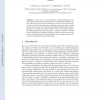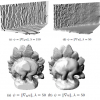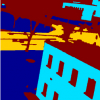2507 search results - page 38 / 502 » Learning Low-Level Vision |
ICVGIP
2004
13 years 10 months ago
2004
In this paper we present a simple framework for activity recognition based on a model of multi-layered finite state machines, built on top of a low level image processing module f...
BC
2002
13 years 8 months ago
2002
Hebb's original postulate left two important issues unaddressed: (i) what is the effective time window between pre- and postsynaptic activity that will result in potentiation?...
SAB
2010
Springer
13 years 6 months ago
2010
Springer
Abstract. In this work, we are interested in understanding how emotional interactions with a social partner can bootstrap increasingly complex behaviors such as social referencing....
CVPR
2009
IEEE
15 years 3 months ago
2009
IEEE
Convex and continuous energy formulations for low level
vision problems enable efficient search procedures for the
corresponding globally optimal solutions. In this work we
exte...
ICCV
2009
IEEE
15 years 1 months ago
2009
IEEE
The concept of graph cuts is by now a standard method
for all sorts of low level vision problems. Its popularity is
largely due to the fact that globally or near globally optimal...



